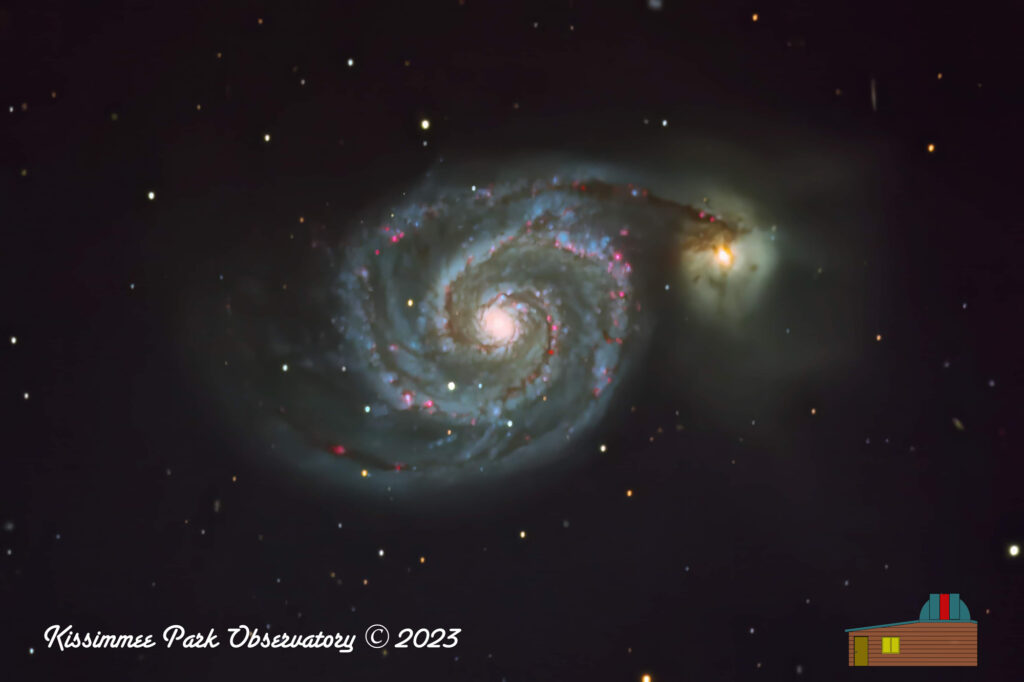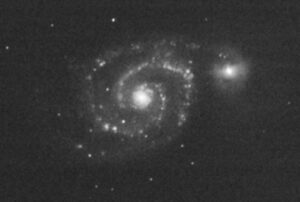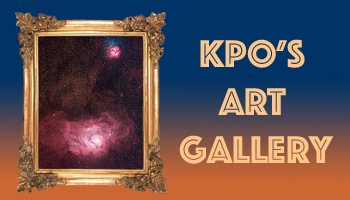Here is M51, better known as the Whirlpool Galaxy, taken with the RC-12 astrograph at KPO.
The Whirlpool Galaxy, also known as M51, is a stunning celestial object that has fascinated astronomers and stargazers for centuries. Located approximately 23 million light-years away from Earth in the constellation Canes Venatici, this galaxy is a beautiful spiral galaxy that is interacting with a smaller companion galaxy.
At the heart of the Whirlpool Galaxy lies a supermassive black hole that is millions of times more massive than the sun. This black hole is thought to be responsible for the strong gravitational forces that are shaping the galaxy’s structure. The Whirlpool Galaxy is also home to many young and bright stars, as well as a large number of star clusters and nebulae.
The Whirlpool Galaxy was first discovered by the French astronomer Charles Messier in 1773. Since then, it has been studied extensively by astronomers around the world, including the Hubble Space Telescope. The Hubble Space Telescope has captured some of the most stunning images of the Whirlpool Galaxy, revealing its intricate spiral arms and bright star clusters in incredible detail.
One of the most fascinating aspects of the Whirlpool Galaxy is its interaction with its companion galaxy, NGC 5195. This interaction has caused a tidal disruption that has led to the formation of new stars and the distortion of the galaxy’s spiral arms. This process has also led to the formation of a bridge of gas and dust that connects the two galaxies, which can be seen in high-resolution images.
The Whirlpool Galaxy is a popular target for amateur astronomers, who can observe it with a small telescope or binoculars. It is best observed during the spring and summer months in the northern hemisphere, when it is high in the sky. Observers can look for its spiral arms and bright core, as well as the fainter companion galaxy NGC 5195. A dark observing site and a large telescope is needed to successfully view this denizen of the deep sky. In the KPO 18″ Reflector at the Winter Star Party in the Florida Keys, it was easy to see the direction of the spiral arm rotation, and the connecting arm between the two galaxies was clearly visible. Pretty optimal viewing conditions.
The Whirlpool Galaxy is a fascinating celestial object that has captured the imagination of astronomers and stargazers for centuries. Its stunning spiral arms, bright star clusters, and interaction with its companion galaxy make it a popular target for observation and study. Whether observed through a telescope or captured by the Hubble Space Telescope, the Whirlpool Galaxy is a true marvel of the universe.
This is an HaLRGB image, in which the Hydrogen Alpha filter reveals the many nebulae spread among the spiral arms of the galaxy – these are the pink areas in the main image.
This is the stack of 5 images taken with the Hydrogen Alpha filter. The nebulae now define the shape of the spiral arms – all the fuzzy dots are all places of stellar birth.
The new telescope and imaging technology has allowed a significant leap in detail and brightness of this galaxy image. The previous version, taken with the KPO 18″ Reflector and a Canon 60D camera in 2016 can be found here.
Click on the images to view a larger version that you can explore.
Image Info
- Imaged from the KPO field, in Saint Cloud, Florida
- Camera : ZWO ASI1600MM Pro
- Scope: Orion RC-12 Ritchey-Chretien Astrograph, 2450mm fl, F/8
- Mount: iOptron CEM-120
- Hydrogen Alpha: 5 subframes of 300s = 25 min integration
- Green: 10 subframes of 300s = 50 min integration
- Blue: 6 subframes of 300s = 30 min integration
- Luminance: 44 subframes of 300s = 220 min integration
- Total integration time: 325 min = 5.4 hours.
- Captured via ASIAir Pro automation
- Optical tracking via ASIAir automation via the ASI120MM-S guide camera
- Separate channels stacked and LRGB integrated in Astro Pixel Processor
- Image cropped, stretched, and noise processed in Nebulosity.
- Image run through Topaz Denoise AI
- Final processing in Aperture
Buy this image as a print or framed art piece in our Art Gallery.



